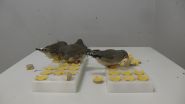Satellite sees birth of Tropical Storm Felicia in Eastern Pacific Ocean
2015-07-23
(Press-News.org) Tropical Storm Felicia was born early on July 23 in the Eastern Pacific Ocean, over 400 miles southwest of Baja California's southern tip. NOAA's GOES-West satellite provided an infrared image of the newborn storm.
Previously known as tropical low pressure area "System 99E," the storm finally developed after days of remaining unorganized. NOAA's GOES-West satellite captured an image of Tropical Storm Felicia on July 23, 2015 at 15:45 UTC (11:45 a.m. EDT). Satellite imagery shows that a curved band of thunderstorms are wrapping around the southern quadrant of the storm.
The low pressure area became Tropical Depression 7E at 5 a.m. EDT (0900 UTC) on July 23. By 11 a.m. EDT (1500 UTC) the depression strengthened into a tropical storm and was named Felicia. At that time, Felicia was located near latitude 19.1 North, longitude 114.9 West. Felicia was moving toward the northwest near 13 mph (20 kph) and is forecast to turn to the west-northwest is forecast by Friday night, July 24. Maximum sustained winds were near 40 mph (65 kph).
The National Hurricane Center's forecaster Brennan noted that Tropical Storm Felicia doesn't seem to have much of a chance to develop much more as it's heading into cooler waters and moderate northerly vertical wind shear is expected to continue until it gets into those cooler waters. The area it is headed toward are 26 Celsius (78.8 Fahrenheit), and tropical cyclones need sea surface temperatures of at least 26.6 Celsius (80 Fahrenheit) to maintain or increase intensity.
The National Hurricane Center expects Felicia to weaken late on July 24 and become a remnant low pressure area over the weekend of July 25 and 26.
INFORMATION:
[Attachments] See images for this press release:

ELSE PRESS RELEASES FROM THIS DATE:
2015-07-23
Researchers in the Division of Hematology, Oncology and Blood & Marrow Transplantation at Children's Hospital Los Angeles have shown greatly improved outcomes in using stem cell transplantation to treat patients with a serious but very rare form of chronic blood cancer called juvenile myelomonocytic leukemia (JMML).
Allogeneic hematopoietic stem cell transplantation (HSCT) involves the transplantation of stem cells from a donor, which may be derived from bone marrow, peripheral blood or umbilical cord blood. The recipient's immune system is usually destroyed with radiation ...
2015-07-23
Researchers from Scripps Institution of Oceanography at UC San Diego have accurately mapped out the movement of the devastating 7.8-magnitude Nepal earthquake that killed over 9,000 and injured over 23,000 people. Scientists have determined that the earthquake was a rupture consisting of three different stages. The study could help a rapidly growing region understand its future seismic risks.
The Himalayan region is particularly prone to earthquakes and this study will serve as an important benchmark for understanding where future earthquakes may occur, especially ...
2015-07-23
SEDE BOQER, Israel...July 23, 2015 - Ben-Gurion University of the Negev (BGU) and University of Western Australia researchers have developed a new process to develop few-layer graphene for use in energy storage and other material applications that is faster, potentially scalable and surmounts some of the current graphene production limitations.
Graphene is a thin atomic layer of graphite (used in pencils) with numerous properties that could be valuable in a variety of applications, including medicine, electronics and energy. Discovered only 11 years ago, graphene is one ...
2015-07-23
The physical symptoms of weakness and fatigue from multiple sclerosis (MS) can rock a person's confidence and ability to engage in what he or she feels is important, from being a good parent and friend to taking up a hobby, according to Matthew Plow, assistant professor from Case Western Reserve University's Frances Payne Bolton School of Nursing.
To help people with MS maintain autonomy and independence, a team of researchers set out to determine what factors prevented individuals from undertaking and enjoying the activities they believe are most important to live fulfilling ...
2015-07-23
Researchers at the University of Birmingham have made a breakthrough in understanding how mutated genes in leukaemia reprogram blood stem cells and send them spiralling out of control.
The findings help to explain the early development of leukaemia, representing the essential first step to developing new treatments for patients based on these findings.
A study, published in Cell Reports by Professors Peter Cockerill and Constanze Bonifer, investigated the role of one specific mutation in the FLT3 gene found in acute myeloid leukaemia (AML).
AML is diagnosed in ...
2015-07-23
Researchers add a new twist to the more than century old biological principles of Mendelian inheritance - describing a small group of cells in pregnant mothers that promote genetic fitness and multi-generational reproductive health.
Scientists at Cincinnati Children's Hospital Medical Center report their findings online July 23 in Cell. The study suggests a scientific basis for developing new therapies to promote reproductive health and prevent pregnancy complications like prematurity and stillbirth, according to Sing Sing Way, MD, PhD, senior author and pediatrician ...
2015-07-23
When does aging really begin? Two Northwestern University scientists now have a molecular clue. In a study of the transparent roundworm C. elegans, they found that adult cells abruptly begin their downhill slide when an animal reaches reproductive maturity.
A genetic switch starts the aging process by turning off cell stress responses that protect the cell by keeping important proteins folded and functional. The switch is thrown by germline stem cells in early adulthood, after the animal starts to reproduce, ensuring its line will live on.
While the studies were conducted ...
2015-07-23
Highly-social zebra finches learn foraging skills from their parents. However, new research has found that when juvenile finches are exposed to elevated stress hormones just after hatching, they will later switch strategies and learn only from unrelated adult birds - ignoring their parents' way of doing things and instead gaining foraging skills from the wider network of other adult finches.
Researchers say that spikes in stress during early development may act as a cue that their parents are doing something wrong, triggering the young birds to switch their social learning ...
2015-07-23
If you find yourself downing that extra piece of chocolate fudge cake even though you're not hungry, it might be the absence of a hormone in your brain that's causing you to overeat purely for pleasure.
In a new Rutgers Robert Wood Johnson Medical School study published in Cell Reports, researchers found that when the hormone glucagon like peptide-1 (GLP-1) was reduced in the central nervous system of laboratory mice, they overate and consumed more high fat food.
"The mice in which the GLP-1 deficiency was induced ate beyond the need for calories and showed an increase ...
2015-07-23
A new study by researchers at University of California, San Diego School of Medicine reveals a protein's critical - and previously unknown -- role in the development and progression of acute myeloid leukemia (AML), a fast-growing and extremely difficult-to-treat blood cancer.
The finding offers a novel target for better treating AML, and possibly other cancers, by cutting off the ability of tumors to access nearby cellular players that feed its growth. The study was published July 23 in Cell Stem Cell.
"The work really focuses on trying to understand the dependence ...
LAST 30 PRESS RELEASES:
[Press-News.org] Satellite sees birth of Tropical Storm Felicia in Eastern Pacific Ocean

